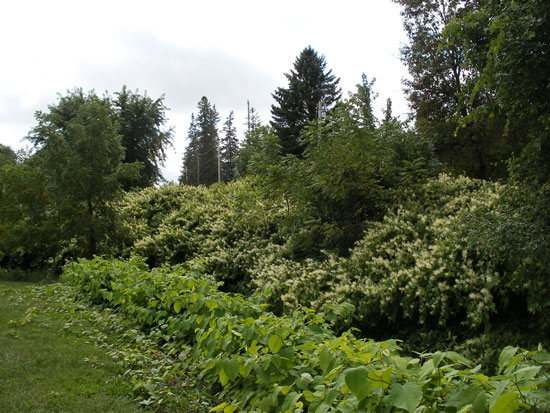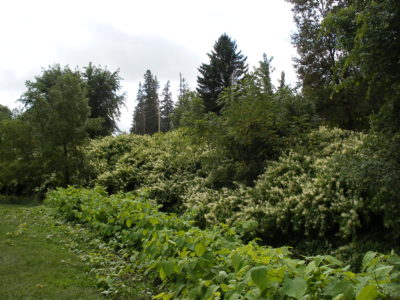
30 Dec Japanese Knotweed Eradication Project in Paint Creek
Paint Creek Japanese Knotweed Map-click here

Japanese knotweed infestation at the headwaters of Paint Creek in Waukon, IA.
Northeast Iowa Resource Conservation & Development (RC&D), the IA DNR, the US Forest Service, IA Natural Heritage Foundation, Allamakee County Supervisors, and area landowners have partnered together to implement a new three year initiative to control Japanese Knotweed (Fallopia japonica) in the Paint Creek Watershed of Allamakee County.
Japanese Knotweed is an extremely aggressive perennial plant introduced into the US in the late 1800s and widely planted for landscaping and erosion control. The 2013 Iowa Legislature recognized the severity of the problem and passed a law signed by Governor Branstad prohibiting the import, sale, offer for sale, or distribution of several invasive ornamental plants including Japanese Knotweed. The plant has not been declared a noxious weed at this time.
Japanese knotweed spreads rapidly by roots as much as 9 feet deep and rhizomes spread horizontally as much as 60 feet. The horizontal roots send up multiple shoots and can even push their way under streets and up through pavement. Currently it is widely believed that it does not spread via seeds. When cut, if not treated with herbicide, the plant sends up multiple sprouts. And, pieces as small as ½ inch can sprout new roots, so any stem or root parts dropped into flowing water can float downstream, lodge in a new place along the stream, and start a new colony. In wild areas, especially riparian sites such as along Paint Creek, the plant colonizes rapidly along the stream banks and into surrounding pastures and woodlands.
Bill Kalishek, Iowa DNR Fisheries Biologist recently stated “Japanese Knotweed is an invasive plant that can grow in such great densities that it completely crowds out all other plant life. Paint Creek watershed has probably the worst infestation of Japanese knotweed that I have seen in northeast Iowa. It is important to try to control this plant in this watershed before it is so widespread that control will be impossible.”
RC&D will work with private landowners upstream from the Yellow River State Forest, educating and demonstrating various control techniques including stem injection and stem bending or cutting followed later by foliar treatment. As much of the infested areas as possible will be treated with the ultimate goal of complete eradication of the Japanese Knotweed in the watershed. However, because of the current extent of the plant and its tenacity, three years will not be enough time to accomplish the goal. It is hoped that initial success will encourage more partners to join the effort. This is the first and largest eradication effort of its kind undertaken in Iowa. Volunteers in the effort are needed and will be heartily welcomed!
For further information or to volunteer to help, please contact Project Coordinator Richard Kittelson at NE IA RC&D at 563-864-7112 or kittelson@northeastiowarcd.org.


